old sports history
Download as ppt, pdf1 like513 views
ЩҠШӘЩҶШ§ЩҲЩ„ Ш§Щ„Щ…ШіШӘЩҶШҜ ШӘШ§ШұЩҠШ® Ш§Щ„ШӘШұШЁЩҠШ© Ш§Щ„ШЁШҜЩҶЩҠШ© ЩҒЩҠ Ш§Щ„ШӯШ¶Ш§ШұШ§ШӘ Ш§Щ„ЩӮШҜЩҠЩ…Ш©ШҢ ШЁШҜШЎЩӢШ§ Щ…ЩҶ Ш§Щ„ШӯШ¶Ш§ШұШ§ШӘ Ш§Щ„ШҙШұЩӮЩҠШ© Щ…Ш«Щ„ Ш§Щ„Щ…ШөШұЩҠЩҠЩҶ ЩҲШ§Щ„ЩҒШұШі ЩҲШ§Щ„ШөЩҠЩҶЩҠЩҠЩҶШҢ ЩҲШ§ЩҶШӘЩҮШ§ШЎЩӢ ШЁШ§Щ„ШӯШ¶Ш§ШұШ§ШӘ Ш§Щ„ШәШұШЁЩҠШ© Щ…Ш«Щ„ Ш§Щ„ЩҠЩҲЩҶШ§ЩҶ ЩҲШ§Щ„ШұЩҲЩ…Ш§ЩҶ. ЩҠШЁШұШІ Ш§Щ„Щ…ШіШӘЩҶШҜ Ш§Щ„Щ…ШёШ§ЩҮШұ Ш§Щ„Щ…Ш®ШӘЩ„ЩҒШ© Щ„Щ„ШұЩҠШ§Ш¶Ш© ЩҒЩҠ ЩҮШ°ЩҮ Ш§Щ„ШӯШ¶Ш§ШұШ§ШӘШҢ ШЁЩ…Ш§ ЩҒЩҠ Ш°Щ„Щғ Ш§Щ„ШұЩҠШ§Ш¶Ш§ШӘ Ш§Щ„Ш№ШіЩғШұЩҠШ© ЩҲШ§Щ„ШҜЩҠЩҶЩҠШ© ЩҲШ§Щ„ШӘШұЩҲЩҠШӯЩҠШ©. ШӘШұЩғШІ Ш§Щ„ЩҲШ«ЩҠЩӮШ© Ш№Щ„Щү Ш§Щ„ЩҒШұЩҲЩӮШ§ШӘ ЩҒЩҠ ШЈЩҶЩҲШ§Ш№ Ш§Щ„ШұЩҠШ§Ш¶Ш© ЩҲЩ…Щ…Ш§ШұШіШ§ШӘЩҮШ§ Ш¶Щ…ЩҶ ЩғЩ„ ШӯШ¶Ш§ШұШ©.
1 of 9
Download to read offline
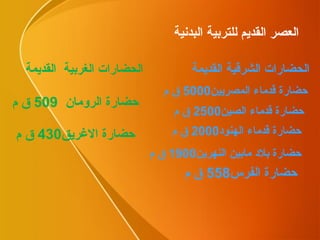

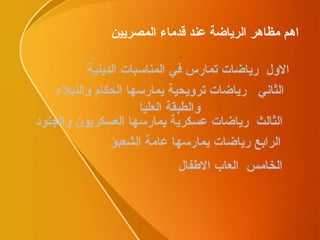
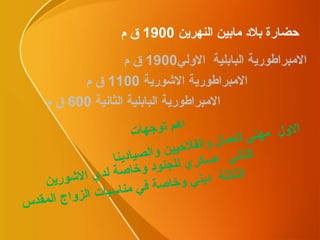
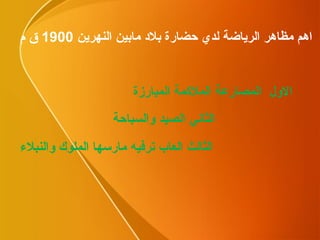

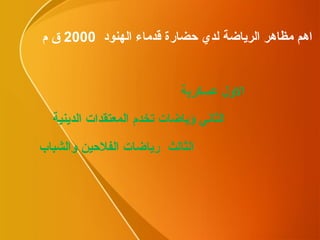
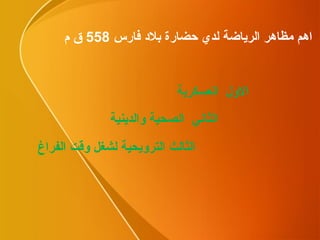

Ad
Recommended
ШӯШ¶Ш§ШұШ© Щ…ШөШұ ЩҒШ¬Шұ Ш§Щ„Ш¶Щ…ЩҠШұ- Ш§ЩҶШӘШөШ§Шұ ШәШұЩҠШЁ
ШӯШ¶Ш§ШұШ© Щ…ШөШұ ЩҒШ¬Шұ Ш§Щ„Ш¶Щ…ЩҠШұ- Ш§ЩҶШӘШөШ§Шұ ШәШұЩҠШЁEntessar Gharieb
Мэ
Ш§Щ„ШӯШ¶Ш§ШұШ© Ш§Щ„Щ…ШөШұЩҠШ© Ш§Щ„ЩӮШҜЩҠЩ…Ш© ШӘЩҸШ№ШӘШЁШұ Щ…ЩҶ ШЈШ№ШёЩ… Ш§Щ„ШӯШ¶Ш§ШұШ§ШӘ ЩҒЩҠ Ш§Щ„ШӘШ§ШұЩҠШ®ШҢ ШӯЩҠШ« ШЈШіШіШӘ Ш№Щ„Щү Ш№ШҜШ© ШЈШұЩғШ§ЩҶ ШЈШіШ§ШіЩҠШ© Щ…Ш«Щ„ Ш§Щ„ШІШұШ§Ш№Ш© ЩҲШ§Щ„ШӘЩҶШёЩҠЩ… Ш§Щ„Ш§Ш¬ШӘЩ…Ш§Ш№ЩҠ. ШҙЩҮШҜШӘ ЩҮШ°ЩҮ Ш§Щ„ШӯШ¶Ш§ШұШ© ШӘШ·ЩҲШұЩӢШ§ ЩҒЩҠ Щ…Ш¬Ш§Щ„Ш§ШӘ Щ…ШӘШ№ШҜШҜШ© ЩғШ§Щ„Ш№Щ„Щ… ЩҲШ§Щ„ЩҒЩҶ ЩҲШ§Щ„ШҜЩҠЩҶШҢ ЩҲЩӮШҜ ШЈШіЩҮЩ…ШӘ ЩҒЩҠ ШЁЩҶШ§ШЎ Щ…Ш¬ШӘЩ…Ш№ Щ…ЩҶШёЩ… ЩҠШ№ШӘЩ…ШҜ Ш№Щ„Щү ЩӮЩҠЩ… Ш§Щ„Щ…ЩҲШ§Ш·ЩҶШ© ЩҲШ§ШӯШӘШұШ§Щ… Ш§Щ„ШҘЩҶШіШ§ЩҶ. ЩғЩ…Ш§ ШӘШұЩғ Ш§Щ„Щ…ШөШұЩҠЩҲЩҶ Ш§Щ„ЩӮШҜЩ…Ш§ШЎ ШҘШұШ«ЩӢШ§ Ш«ЩӮШ§ЩҒЩҠЩӢШ§ ЩҲШ№Щ„Щ…ЩҠЩӢШ§ Ш№Щ…ЩҠЩӮЩӢШ§ ЩҠЩғШҙЩҒ Ш№ЩҶ ШӘЩӮШҜЩҠШұЩҮЩ… Щ„Щ„Ш¬Щ…Ш§Щ„ ЩҲШ§Щ„ШӘШ№Щ„ЩҠЩ….1
1Mowahadi Mowahadi
Мэ
ШӯШ¶Ш§ШұШ© ШЁЩ„ШҜ Ш§Щ„ШұШ§ЩҒШҜЩҠЩҶШҢ Ш§Щ„ШӘЩҠ ЩҶШҙШЈШӘ ШЁЩҠЩҶ ЩҶЩҮШұЩҠ ШҜШ¬Щ„Ш© ЩҲШ§Щ„ЩҒШұШ§ШӘШҢ Ш№ЩҸШұЩҒШӘ ШЁШӘЩҶЩҲШ№ЩҮШ§ ЩҲШәЩҶШ§ЩҮШ§ШҢ ЩҲШёЩҮШұШӘ ШӯЩҲШ§Щ„ЩҠ 3500 ЩӮ.Щ…. ШӘЩ…ЩҠШІШӘ ШЁЩғШӘШ§ШЁШ© Щ…ШіЩ…Ш§ШұЩҠШ© ЩҲЩӮШ§ЩҶЩҲЩҶ ШӯЩ…ЩҲШұШ§ШЁЩҠШҢ ШҘШ° ШіШ§Ш№ШҜШӘ Ш§Щ„ЩғШӘШ§ШЁШ© Ш№Щ„Щү ШӘЩҶШёЩҠЩ… Ш§Щ„Щ…Ш¬ШӘЩ…Ш№ ЩҲШ®Щ„ЩӮШӘ Ш·ШЁЩӮШ© Щ…ЩҶ Ш§Щ„ЩғШӘЩ‘Ш§ШЁ Ш°ЩҲЩҠ Ш§Щ„ЩҶЩҒЩҲШ°. ШӘШ№ШӘШЁШұ ЩҮШ°ЩҮ Ш§Щ„ШӯШ¶Ш§ШұШ© ЩҲШ§ШӯШҜШ© Щ…ЩҶ ШЈЩӮШҜЩ… Ш§Щ„ШӯШ¶Ш§ШұШ§ШӘ Ш§Щ„ШӘЩҠ ШЈШ«ШұШӘ ЩҒЩҠ ШӘШ§ШұЩҠШ® Ш§Щ„ШЁШҙШұЩҠШ©.Ш§Щ„ШӯШ¶Ш§ШұЩҮ Ш§Щ„Щ…ШөШұЩҠЩҮ
Ш§Щ„ШӯШ¶Ш§ШұЩҮ Ш§Щ„Щ…ШөШұЩҠЩҮKarim Badawy
Мэ
ЩҠШӘЩҶШ§ЩҲЩ„ Ш§Щ„ЩҶШө ШӯШ§Щ„Ш© Ш§Щ„ШіЩғЩҶ ЩҲШ§Щ„Ш№ЩҠШҙ ЩҒЩҠ Ш§Щ„Ш№ШөЩҲШұ Ш§Щ„ЩҒШұШ№ЩҲЩҶЩҠШ©ШҢ ШӯЩҠШ« ШӘШӘЩҶЩҲШ№ Щ…ШіШӘЩҲЩҠШ§ШӘ Ш§Щ„Щ…Ш№ЩҠШҙШ© ШЁЩҠЩҶ Ш§Щ„Ш·ШЁЩӮШ§ШӘ Ш§Щ„Ш§Ш¬ШӘЩ…Ш§Ш№ЩҠШ©. ШӘШөЩҒ Ш§Щ„ШЁЩҠЩҲШӘ Ш§Щ„ЩҒШ®Щ…Ш© Щ„Щ„ШЈШ«ШұЩҠШ§ШЎ ШЁЩ…ШіШ§ШӯШ§ШӘЩҮШ§ Ш§Щ„ЩҲШ§ШіШ№Ш© ЩҲШӯШҜШ§ШҰЩӮЩҮШ§ШҢ Щ…ЩӮШ§ШұЩҶШ© ШЁЩ…ШіШ§ЩғЩҶ Ш§Щ„ЩҒЩ„Ш§ШӯЩҠЩҶ ЩҲШ§Щ„Ш№Щ…Ш§Щ„ Ш§Щ„ШЁШіЩҠШ·Ш©. ЩғЩ…Ш§ ЩҠШЁШұШІ Ш§Щ„ЩҶШө ШӘЩҒШ§ШөЩҠЩ„ Ш§Щ„ШЈШ«Ш§Ш« Ш§Щ„Щ…ШіШӘШ®ШҜЩ… ЩҒЩҠ ШӘЩ„Щғ Ш§Щ„ЩҒШӘШұШ© ЩҲЩғЩҠЩҒ ЩғШ§ЩҶ ЩҠШ№ЩғШі Ш§Щ„ШұЩҒШ§ЩҮЩҠШ© ЩҲШ§Щ„ШӘШұЩҒ.ЩҲШ§ШҜЩү Ш§Щ„ЩҶЩҠЩ„
ЩҲШ§ШҜЩү Ш§Щ„ЩҶЩҠЩ„omar_egypt
Мэ
ЩҲШ§ШҜЩү Ш§Щ„ЩҶЩҠЩ„ ЩҮЩҲ Щ…ЩҶШ·ЩӮШ© Ш®ШөШЁШ© ЩҒЩҠ ШөШ№ЩҠШҜ Щ…ШөШұ ШӘЩ…ШӘШҜ Щ…ЩҶ Ш§Щ„Ш¬ЩҠШІШ© ШҘЩ„Щү ШЈШіЩҲШ§ЩҶШҢ Щ…ШҙЩҮЩҲШұШ© ШЁШІШұШ§Ш№Ш© ЩӮШөШЁ Ш§Щ„ШіЩғШұ ЩҲШ§ШӯШӘЩҲШ§ШҰЩҮШ§ Ш№Щ„Щү ШўШ«Ш§Шұ ЩҒШұШ№ЩҲЩҶЩҠШ© Щ…ЩҮЩ…Ш©. ШӘЩҸШ№ШҜ ШЁШӯЩҠШұШ© ЩҶШ§ШөШұ ШЈЩғШЁШұ ШЁШӯЩҠШұШ© ШөЩҶШ§Ш№ЩҠШ© ЩҒЩҠ Ш§Щ„Ш№Ш§Щ„Щ…ШҢ ЩҲШӘШӘЩғЩҲЩҶ ЩҶШӘЩҠШ¬Ш© ШӘШ¬Щ…Ш№ Ш§Щ„Щ…ЩҠШ§ЩҮ ШЈЩ…Ш§Щ… Ш§Щ„ШіШҜ Ш§Щ„Ш№Ш§Щ„ЩҠШҢ Щ…Щ…Ш§ ЩҠШ№ЩғШі Ш§Щ„ШЈЩҮЩ…ЩҠШ© Ш§Щ„Ш§ЩӮШӘШөШ§ШҜЩҠШ© Щ„ЩҶЩҮШұ Ш§Щ„ЩҶЩҠЩ„ ЩҒЩҠ Ш§Щ„ШІШұШ§Ш№Ш© ЩҲШ§Щ„ШөЩҠШҜ ЩҲШ§Щ„ШіЩҠШ§ШӯШ©. ШӘШӘЩ…ЩҠШІ Ш§Щ„Щ…ЩҶШ·ЩӮШ© ШЁШ§ШұШӘЩҒШ§Ш№ ШҜШұШ¬Ш§ШӘ Ш§Щ„ШӯШұШ§ШұШ© Ш§Щ„Щ…Ш№ШӘШҜЩ„Ш© ЩҒЩҠ Ш§Щ„ШҙШӘШ§ШЎ ЩҲЩӮЩ„Ш© Ш§Щ„ШЈЩ…Ш·Ш§Шұ.Assyria & ancient east architecture
Assyria & ancient east architecture Olfat abd elghany helwa
Мэ
ЩҠШӘЩҶШ§ЩҲЩ„ Ш§Щ„ЩҲШ«ЩҠЩӮШ© Ш§Щ„Ш№Щ…Ш§ШұШ© ЩҒЩҠ ШЁЩ„Ш§ШҜ Щ…Ш§ ШЁЩҠЩҶ Ш§Щ„ЩҶЩҮШұЩҠЩҶ (Щ…ЩҠШІЩҲШЁЩҲШӘШ§Щ…ЩҠШ§) Щ…ЩҶ Ш®Щ„Ш§Щ„ Ш№ШұШ¶ ШӘШ§ШұЩҠШ®ЩҮШ§ ЩҲШӘШ·ЩҲШұШ§ШӘЩҮШ§ Ш№ШЁШұ Ш§Щ„Ш№ШөЩҲШұ Ш§Щ„Щ…Ш®ШӘЩ„ЩҒШ© ШЁШҜШЎЩӢШ§ Щ…ЩҶ Ш§Щ„ШӯШ¶Ш§ШұШ© Ш§Щ„ШіЩҲЩ…ШұЩҠШ© ЩҲШӯШӘЩү Ш§Щ„ЩҒШ§ШұШіЩҠШ©. ЩғЩ…Ш§ ЩҠШіШӘШ№ШұШ¶ Ш§Щ„Ш№ЩҲШ§Щ…Щ„ Ш§Щ„Ш¬ШәШұШ§ЩҒЩҠШ© ЩҲШ§Щ„ШҜЩҠЩҶЩҠШ© ЩҲШ§Щ„Ш§Ш¬ШӘЩ…Ш§Ш№ЩҠШ© Ш§Щ„ШӘЩҠ ШЈШ«ШұШӘ Ш№Щ„Щү ШҙЩғЩ„ ЩҲШӘЩғЩҲЩҠЩҶ Ш§Щ„Ш№Щ…Ш§ШұШ© ШЁШӘЩ„Щғ Ш§Щ„ЩҒШӘШұШ©ШҢ ШЁШ§Щ„ШҘШ¶Ш§ЩҒШ© ШҘЩ„Щү ШЈЩҶЩҲШ§Ш№ Ш§Щ„Щ…ШЁШ§ЩҶЩҠ Щ…Ш«Щ„ Ш§Щ„Щ…Ш№Ш§ШЁШҜ ЩҲШ§Щ„ЩӮШөЩҲШұ. ШӘЩ… ШӘЩҲШ¶ЩҠШӯ ШЁШЈШіЩ„ЩҲШЁ ШӘШіЩ„ШіЩ„ЩҠ Ш§Щ„ЩҒШӘШұШ§ШӘ Ш§Щ„ШІЩ…ЩҶЩҠШ© ЩҲЩғЩҠЩҒЩҠШ© Ш§ШұШӘШЁШ§Ш· Ш§Щ„Ш№Щ…Ш§ШұШ© ШЁШӘШ·ЩҲШұ Ш§Щ„Щ…Ш¬ШӘЩ…Ш№Ш§ШӘ ШўЩҶШ°Ш§Щғ. Ш№Щ…Ш§ШұШ© ШЁЩ„Ш§ШҜ Щ…Ш§ШЁЩҠЩҶ Ш§Щ„ЩҶЩҮШұЩҠЩҶ
Ш№Щ…Ш§ШұШ© ШЁЩ„Ш§ШҜ Щ…Ш§ШЁЩҠЩҶ Ш§Щ„ЩҶЩҮШұЩҠЩҶOlfat abd elghany helwa
Мэ
ЩҠШӘЩҶШ§ЩҲЩ„ Ш§Щ„ЩҲШ«ЩҠЩӮШ© ШӘШ§ШұЩҠШ® Ш§Щ„Ш№Щ…Ш§ШұШ© ЩҒЩҠ ШЁЩ„Ш§ШҜ Ш§Щ„ШұШ§ЩҒШҜЩҠЩҶШҢ ШӯЩҠШ« ШӘЩ…ШӘШҜ ШӯШ¶Ш§ШұШ§ШӘЩҮШ§ Щ…ЩҶ Ш§Щ„ШіЩҲЩ…ШұЩҠШ©ШҢ Ш§Щ„ШЈЩғШ§ШҜЩҠШ©ШҢ Ш§Щ„ШЁШ§ШЁЩ„ЩҠШ©ШҢ Ш§Щ„ШўШҙЩҲШұЩҠШ© ШҘЩ„Щү Ш§Щ„ЩҒШ§ШұШіЩҠШ© ШЁЩҠЩҶ 4000 ЩҲ 330 ЩӮШЁЩ„ Ш§Щ„Щ…ЩҠЩ„Ш§ШҜ. ШӘШЁШұШІ Ш№ЩҲШ§Щ…Щ„ Ш¬ШәШұШ§ЩҒЩҠШ© ЩҲШҜЩҠЩҶЩҠШ© ЩҲШ¬ЩҠЩҲЩ„ЩҲШ¬ЩҠШ© ЩҒЩҠ ШӘШҙЩғЩҠЩ„ Ш§Щ„Ш№Щ…Ш§ШұШ© Ш§Щ„Щ…Щ…ЩҠШІШ© Щ„Щ„ШӯЩӮШЁ Ш§Щ„ШӘШ§ШұЩҠШ®ЩҠШ©ШҢ ЩҲШӘШЈШ«ЩҠШұ ШЈЩҲШ§ШөШұ Ш§Щ„ШЈЩҶЩҮШ§Шұ ЩҲШ§Щ„Щ…ЩҲШ§ШұШҜ Ш§Щ„Ш·ШЁЩҠШ№ЩҠШ© ЩҒЩҠ ШӘШ·ЩҲШұЩҮШ§. ШӘЩҶЩӮШіЩ… Ш§Щ„Щ…Ш¬ШӘЩ…Ш№Ш§ШӘ ШўЩҶШ°Ш§Щғ ШҘЩ„Щү Ш·ШЁЩӮШ§ШӘ Ш§Ш¬ШӘЩ…Ш§Ш№ЩҠШ© Щ…ШӘШ№ШҜШҜШ© ШӘШҙЩ…Щ„ Ш§Щ„Щ…Ш§Щ„ЩғЩҠЩҶ ЩҲШ§Щ„ШЈШ¬ШұШ§ШЎ ЩҲШ§Щ„Ш№ШЁЩҠШҜШҢ Щ…Щ…Ш§ ШЈШ«Шұ ЩҒЩҠ ЩҶЩ…Ш· Ш§Щ„ШӯЩҠШ§Ш© ЩҲШ§Щ„Щ…Ш№Щ…Ш§Шұ.The Assyrian Empire
The Assyrian Empireguest98b6c0
Мэ
The geography of Assyria significantly influenced its development as an empire, with fertile lands and access to the Tigris and Euphrates rivers facilitating agriculture and military expansion. Assyria, located in northern Mesopotamia, was characterized by a flat landscape that promoted a warlike culture and a merciless policy towards conquered peoples. The empire ultimately fell due to its violent reputation and the formation of a united army against it, leading to the destruction of its capital, Nineveh.Ш§Щ„ШӯШ¶Ш§ШұШ© Ш§Щ„ЩҒШұШ№ЩҲЩҶЩҠШ©
Ш§Щ„ШӯШ¶Ш§ШұШ© Ш§Щ„ЩҒШұШ№ЩҲЩҶЩҠШ©Ahmed SHoukry ELhfnawy
Мэ
ШӘЩҶШ§ЩӮШҙ Ш§Щ„ЩҲШ«ЩҠЩӮШ© ШӘШ·ЩҲШұ Ш§Щ„ШӯШ¶Ш§ШұШ© Ш§Щ„Щ…ШөШұЩҠШ© Ш§Щ„ЩӮШҜЩҠЩ…Ш© Ш№ШЁШұ Ш§Щ„Ш№ШөЩҲШұ Ш§Щ„Щ…Ш®ШӘЩ„ЩҒШ©ШҢ ШЁШҜШЎЩӢШ§ Щ…ЩҶ Ш§Щ„Щ…Щ…Щ„ЩғШ© Ш§Щ„ЩӮШҜЩҠЩ…Ш© ШӯШӘЩү Ш§Щ„Ш№ШөШұ Ш§Щ„ЩҠЩҲЩҶШ§ЩҶЩҠ. ШӘШЁШұШІ ШЈЩҮЩ…ЩҠШ© Ш§Щ„Ш№ЩҲШ§Щ…Щ„ Ш§Щ„Ш¬ШәШұШ§ЩҒЩҠШ© ЩҲШ§Щ„ШҜЩҠЩҶЩҠШ© ЩҲШ§Щ„Ш§Ш¬ШӘЩ…Ш§Ш№ЩҠШ© ЩҒЩҠ ШӘШҙЩғЩҠЩ„ Ш§Щ„Ш№Щ…Ш§ШұШ© ЩҲШ§Щ„ЩҒЩҶЩҲЩҶ ЩҲЩҒЩҠ ШӯЩҠШ§Ш© Ш§Щ„Щ…ШөШұЩҠЩҠЩҶ Ш§Щ„ЩӮШҜЩ…Ш§ШЎ. ЩғЩ…Ш§ ШӘШӘЩҶШ§ЩҲЩ„ Ш§Щ„ЩҲШ«ЩҠЩӮШ© ШЈШЁШұШІ Ш§Щ„ШҙШ®ШөЩҠШ§ШӘ ЩҲШ§Щ„ШҘЩҶШ¬Ш§ШІШ§ШӘ Ш§Щ„Щ…Ш№Щ…Ш§ШұЩҠШ©ШҢ Щ…Ш«Щ„ ШЈЩҮШұШ§Щ…Ш§ШӘ Ш§Щ„Ш¬ЩҠШІШ© ЩҲШІЩҲШіШұ.Ш№Щ…Ш§ШұШ© Щ…Ш§ЩӮШЁЩ„ Ш§Щ„ШӘШ§ШұЩҠШ®
Ш№Щ…Ш§ШұШ© Щ…Ш§ЩӮШЁЩ„ Ш§Щ„ШӘШ§ШұЩҠШ®Taha Farwan
Мэ
ЩҠШӘЩҶШ§ЩҲЩ„ Ш§Щ„Щ…ШіШӘЩҶШҜ Щ…ШӯШ§Ш¶ШұШӘЩҠЩҶ Щ…ЩҶ ШҜ/ ШІЩғЩҠ Ш§Щ„ЩҠЩҲШіЩҒЩҠ ШӯЩҲЩ„ ШӘШ§ШұЩҠШ® Ш§Щ„Ш№ШөШұ Ш§Щ„ШӯШ¬ШұЩҠШҢ ШӯЩҠШ« ШӘШіШӘШ№ШұШ¶ Ш§Щ„Щ…ШӯШ§Ш¶ШұШ© Ш§Щ„ШұШ§ШЁШ№Ш© Ш§Щ„Ш№ШөЩҲШұ Ш§Щ„ШӯШ¬ШұЩҠШ© Ш§Щ„Щ…Ш®ШӘЩ„ЩҒШ© ЩҲШӘШ·ШұЩӮ Ш§Щ„Щ…ШӯШ§Ш¶ШұШ© Ш§Щ„Ш®Ш§Щ…ШіШ© ШҘЩ„Щү Ш§Щ„Ш№Щ…Ш§ШұШ© ЩҲШ§Щ„Ш№Щ…ШұШ§ЩҶ Ш®Щ„Ш§Щ„ Ш§Щ„Ш№ШөШұ Ш§Щ„ШӯШ¬ШұЩҠ Ш§Щ„ШӯШҜЩҠШ«. ЩҠШӘЩ… Ш§ШіШӘШ№ШұШ§Ш¶ Ш§Щ„Ш№ЩҶШ§ШөШұ Ш§Щ„Ш«ЩӮШ§ЩҒЩҠШ© ЩҲШ§Щ„ШӘЩҲШІЩҠШ№ Ш§Щ„Ш¬ШәШұШ§ЩҒЩҠ Щ„Щ„ШЈШҜЩҲШ§ШӘ Ш§Щ„Щ…ШіШӘШ®ШҜЩ…Ш© ЩҲШўШ«Ш§ШұЩҮШ§ Ш№Щ„Щү Ш§Щ„Щ…Ш¬ШӘЩ…Ш№Ш§ШӘ Ш§Щ„ШіШ§ШЁЩӮШ©. ЩҠШӘЩ… Ш§Щ„ШӘШ·ШұЩӮ ШЈЩҠШ¶ЩӢШ§ ШҘЩ„Щү Ш§Щ„Ш№ЩҲШ§Щ…Щ„ Ш§Щ„ШЁЩҠШҰЩҠШ© ЩҲШ§Щ„Ш§Ш¬ШӘЩ…Ш§Ш№ЩҠШ© Ш§Щ„ШӘЩҠ ШЈШ«ШұШӘ Ш№Щ„Щү ШӘШ·ЩҲШұ Ш§Щ„Щ…Ш¬ШӘЩ…Ш№Ш§ШӘ ЩҒЩҠ ШӘЩ„Щғ Ш§Щ„Ш№ШөЩҲШұ.Щ…ШӯШ§Ш¶ШұШ§ШӘ ШӘШ§ШұЩҠШ® Ш§Щ„Ш№Щ…Ш§ШұШ©
Щ…ШӯШ§Ш¶ШұШ§ШӘ ШӘШ§ШұЩҠШ® Ш§Щ„Ш№Щ…Ш§ШұШ© Dr Walaa Yoseph
Мэ
Ш§Щ„Ш№Щ…Ш§ШұШ© ШӘШ№ШЁШұ Ш№ЩҶ ШӘШЈШ«ЩҠШұ Ш§Щ„ШЁЩҠШҰШ© Ш№Щ„Щү Ш§Щ„ШӘШөЩ…ЩҠЩ… ЩҲШ·ШұЩӮ ШҜШұШ§ШіШӘЩҮШ§ Ш№ШЁШұ Ш§Щ„Ш№ШөЩҲШұ ЩҲШ§Щ„ШӯШ¶Ш§ШұШ§ШӘ. ШӘШЁЩҠЩҶ Ш§Щ„ЩҲШ«ЩҠЩӮШ© ЩғЩҠЩҒ ШЈЩҶ Ш§Щ„Ш№Щ…Ш§ШұШ© ЩғШ§ЩҶШӘ ШұШҜ ЩҒШ№Щ„ Щ„Щ…ШӘШ·Щ„ШЁШ§ШӘ Ш§Щ„ШЁШҙШұ Ш№ШЁШұ Ш§Щ„ШӘШ§ШұЩҠШ® Щ…Ш«Щ„ Ш§Щ„ШӯШ§Ш¬Ш© Щ„Щ„ШіЩғЩҶ ЩҲШ§Щ„ШӯЩ…Ш§ЩҠШ©. ШӘШҜШұШі Ш§Щ„ЩҲШ«ЩҠЩӮШ© Ш§Щ„Ш№ЩҲШ§Щ…Щ„ Ш§Щ„Щ…ШӨШ«ШұШ© ЩҒЩҠ Ш§Щ„Ш№Щ…Ш§ШұШ© Щ…Ш«Щ„ Ш§Щ„ШЁЩҠШҰШ© Ш§Щ„Ш·ШЁЩҠШ№ЩҠШ© ЩҲШ§Щ„ШҘЩҶШіШ§ЩҶЩҠШ© ЩҲШ§Щ„Ш№Щ…ШұШ§ЩҶЩҠШ©ШҢ ЩҲЩғЩҠЩҒ ШӘШ·ЩҲШұШӘ Ш№ШЁШұ Ш§Щ„ШІЩ…ЩҶ Щ„ШӘЩ„ШЁЩҠШ© Ш§ШӯШӘЩҠШ§Ш¬Ш§ШӘ Ш§Щ„Щ…Ш¬ШӘЩ…Ш№.Babylonian Civilization
Babylonian Civilizationhemangi salunke
Мэ
The document discusses the ancient Babylonian civilization and the city of Babylon. It describes how Babylon was the capital city located along the Euphrates River in Mesopotamia. Under King Hammurabi in the 18th century BC, Babylon became the dominant city-state in the region and established itself as a powerful empire. Key aspects of ancient Babylon discussed include the city walls, temples, ziggurats, and other impressive architectural feats such as the Hanging Gardens, built later under King Nebuchadnezzar II.My hobby
My hobbysliderdlfo
Мэ
The document emphasizes the importance of engaging in hobbies and creative projects to enhance personal growth and happiness. It encourages individuals to explore their inner creativity and contribute their uniqueness to the world. Additionally, it provides sources for inspiration and images related to DIY projects.Sports
SportsAntonio Villodres
Мэ
This document lists various sports and activities and prompts the reader to choose their favorite sport and discuss whether they play, watch, or dislike certain sports. It includes options for ball sports like soccer, basketball, baseball; individual sports such as running, swimming, golf; racket sports like tennis, badminton; winter sports including skiing, ice skating; and other activities such as martial arts, scuba diving, windsurfing.Ancient Mesopotamia (World History)
Ancient Mesopotamia (World History)Tom Richey
Мэ
This PowerPoint was designed to help provide an introduction to ancient Mesopotamia for World History students, with emphasis on writing, geography, and religion.
For more instructional materials, visit www.tomrichey.net!Mesopotamia
MesopotamiaRocГӯo Bautista
Мэ
Mesopotamia was the first civilization in history located between the Tigris and Euphrates Rivers in modern Iraq, Syria, and surrounding areas. It began as independent Sumerian city-states like Ur and Uruk before being unified under empires like the Akkadian, Babylonian, Assyrian, and Neo-Babylonian. Mesopotamian society was hierarchical with kings and priests at the top. Their economy was based on irrigated agriculture and they developed writing, mathematics, astronomy, law codes, and architectural achievements like ziggurats and arches. Their polytheistic religion influenced later civilizations.The benefits of sports
The benefits of sportsCOMM 2213
Мэ
Being involved in sports provides physical and mental health benefits, teaches important life skills like goal setting, teamwork, time management, and leadership, and can help students do better in school and develop friendships, while also allowing participants to have fun.Sport presentation pdf
Sport presentation pdfEva Walkembach
Мэ
This document discusses different types of sports, a brief history of why humans participate in sports, the most popular sports worldwide, and health benefits of playing sports. It lists several websites as sources of additional information on the history of sports, Olympic track star Usain Bolt, basketball player Lebron James, the 2012 London Olympics, and a wiki with an overview of different types of sports.Mesopotamian civilization
Mesopotamian civilizationElena GarcГӯa
Мэ
The document summarizes the early Mesopotamian civilization that developed between the Tigris and Euphrates Rivers. It emerged around 3000 BC and was composed of independent city-states like Ur, Uruk, and Kish that each had their own government and patron god. Sargon of Akkad later created the world's first empire in 2350 BC by conquering the region. The Babylonian Empire then took control around 2000 BC, with King Hammurabi establishing one of the first legal codes. Mesopotamian culture developed writing, the Epic of Gilgamesh, and made advances in religion, society, and government.Mesopotamia power point
Mesopotamia power pointpatricehigh
Мэ
Mesopotamia, located between the Tigris and Euphrates Rivers in modern Iraq, was the site of some of the earliest human civilizations. People first settled there due to natural levees along the rivers that protected against floods while enabling irrigation. Several successive civilizations arose in Mesopotamia over 3000 years, including the Sumerians, Akkadians, Babylonians, and Assyrians. These civilizations developed systems of writing like cuneiform, advanced mathematics, the wheel, and organized religion centered around temples. Though Mesopotamia faced environmental challenges like flooding and lack of resources, its civilizations left lasting legacies as the cradle of modern civilization.Importance of sports
Importance of sportsAnkit Ranjan
Мэ
Sports play an important role in students' development. It keeps kids occupied and instills important life lessons like discipline, teamwork, and work ethic. Sports also help students physically by encouraging exercise and developing motor skills. Participating in sports fosters social and mental well-being by providing healthy outlets for stress and a diversion from risky behaviors. At a national level, success in sports may be linked to a country's overall development.Sports and games
Sports and gamesbkukuckova
Мэ
Sports are usually individual activities while games often involve teams using equipment like balls. Some common sports include athletics, swimming, and gymnastics which are often outdoors or involve training on equipment like horizontal bars. Winter sports include skiing, figure skating and snowboarding. Golf, tennis, baseball and cricket are popular games around the world. The Olympic Games aim to promote physical and mental well-being and spread peace, symbolized by its interlocking rings representing the five inhabited continents.Sports Powerpoint
Sports Powerpointw161470
Мэ
The document provides an overview of various sports, including lacrosse, football, baseball, soccer, rugby, tennis, bowling, badminton, pool, NASCAR and their basic rules. It notes that sports are played throughout the world and are important to some countries. Famous players and aspects of popularity are mentioned for several sports.More Related Content
Viewers also liked (16)
Ш№Щ…Ш§ШұШ© Щ…Ш§ЩӮШЁЩ„ Ш§Щ„ШӘШ§ШұЩҠШ®
Ш№Щ…Ш§ШұШ© Щ…Ш§ЩӮШЁЩ„ Ш§Щ„ШӘШ§ШұЩҠШ®Taha Farwan
Мэ
ЩҠШӘЩҶШ§ЩҲЩ„ Ш§Щ„Щ…ШіШӘЩҶШҜ Щ…ШӯШ§Ш¶ШұШӘЩҠЩҶ Щ…ЩҶ ШҜ/ ШІЩғЩҠ Ш§Щ„ЩҠЩҲШіЩҒЩҠ ШӯЩҲЩ„ ШӘШ§ШұЩҠШ® Ш§Щ„Ш№ШөШұ Ш§Щ„ШӯШ¬ШұЩҠШҢ ШӯЩҠШ« ШӘШіШӘШ№ШұШ¶ Ш§Щ„Щ…ШӯШ§Ш¶ШұШ© Ш§Щ„ШұШ§ШЁШ№Ш© Ш§Щ„Ш№ШөЩҲШұ Ш§Щ„ШӯШ¬ШұЩҠШ© Ш§Щ„Щ…Ш®ШӘЩ„ЩҒШ© ЩҲШӘШ·ШұЩӮ Ш§Щ„Щ…ШӯШ§Ш¶ШұШ© Ш§Щ„Ш®Ш§Щ…ШіШ© ШҘЩ„Щү Ш§Щ„Ш№Щ…Ш§ШұШ© ЩҲШ§Щ„Ш№Щ…ШұШ§ЩҶ Ш®Щ„Ш§Щ„ Ш§Щ„Ш№ШөШұ Ш§Щ„ШӯШ¬ШұЩҠ Ш§Щ„ШӯШҜЩҠШ«. ЩҠШӘЩ… Ш§ШіШӘШ№ШұШ§Ш¶ Ш§Щ„Ш№ЩҶШ§ШөШұ Ш§Щ„Ш«ЩӮШ§ЩҒЩҠШ© ЩҲШ§Щ„ШӘЩҲШІЩҠШ№ Ш§Щ„Ш¬ШәШұШ§ЩҒЩҠ Щ„Щ„ШЈШҜЩҲШ§ШӘ Ш§Щ„Щ…ШіШӘШ®ШҜЩ…Ш© ЩҲШўШ«Ш§ШұЩҮШ§ Ш№Щ„Щү Ш§Щ„Щ…Ш¬ШӘЩ…Ш№Ш§ШӘ Ш§Щ„ШіШ§ШЁЩӮШ©. ЩҠШӘЩ… Ш§Щ„ШӘШ·ШұЩӮ ШЈЩҠШ¶ЩӢШ§ ШҘЩ„Щү Ш§Щ„Ш№ЩҲШ§Щ…Щ„ Ш§Щ„ШЁЩҠШҰЩҠШ© ЩҲШ§Щ„Ш§Ш¬ШӘЩ…Ш§Ш№ЩҠШ© Ш§Щ„ШӘЩҠ ШЈШ«ШұШӘ Ш№Щ„Щү ШӘШ·ЩҲШұ Ш§Щ„Щ…Ш¬ШӘЩ…Ш№Ш§ШӘ ЩҒЩҠ ШӘЩ„Щғ Ш§Щ„Ш№ШөЩҲШұ.Щ…ШӯШ§Ш¶ШұШ§ШӘ ШӘШ§ШұЩҠШ® Ш§Щ„Ш№Щ…Ш§ШұШ©
Щ…ШӯШ§Ш¶ШұШ§ШӘ ШӘШ§ШұЩҠШ® Ш§Щ„Ш№Щ…Ш§ШұШ© Dr Walaa Yoseph
Мэ
Ш§Щ„Ш№Щ…Ш§ШұШ© ШӘШ№ШЁШұ Ш№ЩҶ ШӘШЈШ«ЩҠШұ Ш§Щ„ШЁЩҠШҰШ© Ш№Щ„Щү Ш§Щ„ШӘШөЩ…ЩҠЩ… ЩҲШ·ШұЩӮ ШҜШұШ§ШіШӘЩҮШ§ Ш№ШЁШұ Ш§Щ„Ш№ШөЩҲШұ ЩҲШ§Щ„ШӯШ¶Ш§ШұШ§ШӘ. ШӘШЁЩҠЩҶ Ш§Щ„ЩҲШ«ЩҠЩӮШ© ЩғЩҠЩҒ ШЈЩҶ Ш§Щ„Ш№Щ…Ш§ШұШ© ЩғШ§ЩҶШӘ ШұШҜ ЩҒШ№Щ„ Щ„Щ…ШӘШ·Щ„ШЁШ§ШӘ Ш§Щ„ШЁШҙШұ Ш№ШЁШұ Ш§Щ„ШӘШ§ШұЩҠШ® Щ…Ш«Щ„ Ш§Щ„ШӯШ§Ш¬Ш© Щ„Щ„ШіЩғЩҶ ЩҲШ§Щ„ШӯЩ…Ш§ЩҠШ©. ШӘШҜШұШі Ш§Щ„ЩҲШ«ЩҠЩӮШ© Ш§Щ„Ш№ЩҲШ§Щ…Щ„ Ш§Щ„Щ…ШӨШ«ШұШ© ЩҒЩҠ Ш§Щ„Ш№Щ…Ш§ШұШ© Щ…Ш«Щ„ Ш§Щ„ШЁЩҠШҰШ© Ш§Щ„Ш·ШЁЩҠШ№ЩҠШ© ЩҲШ§Щ„ШҘЩҶШіШ§ЩҶЩҠШ© ЩҲШ§Щ„Ш№Щ…ШұШ§ЩҶЩҠШ©ШҢ ЩҲЩғЩҠЩҒ ШӘШ·ЩҲШұШӘ Ш№ШЁШұ Ш§Щ„ШІЩ…ЩҶ Щ„ШӘЩ„ШЁЩҠШ© Ш§ШӯШӘЩҠШ§Ш¬Ш§ШӘ Ш§Щ„Щ…Ш¬ШӘЩ…Ш№.Babylonian Civilization
Babylonian Civilizationhemangi salunke
Мэ
The document discusses the ancient Babylonian civilization and the city of Babylon. It describes how Babylon was the capital city located along the Euphrates River in Mesopotamia. Under King Hammurabi in the 18th century BC, Babylon became the dominant city-state in the region and established itself as a powerful empire. Key aspects of ancient Babylon discussed include the city walls, temples, ziggurats, and other impressive architectural feats such as the Hanging Gardens, built later under King Nebuchadnezzar II.My hobby
My hobbysliderdlfo
Мэ
The document emphasizes the importance of engaging in hobbies and creative projects to enhance personal growth and happiness. It encourages individuals to explore their inner creativity and contribute their uniqueness to the world. Additionally, it provides sources for inspiration and images related to DIY projects.Sports
SportsAntonio Villodres
Мэ
This document lists various sports and activities and prompts the reader to choose their favorite sport and discuss whether they play, watch, or dislike certain sports. It includes options for ball sports like soccer, basketball, baseball; individual sports such as running, swimming, golf; racket sports like tennis, badminton; winter sports including skiing, ice skating; and other activities such as martial arts, scuba diving, windsurfing.Ancient Mesopotamia (World History)
Ancient Mesopotamia (World History)Tom Richey
Мэ
This PowerPoint was designed to help provide an introduction to ancient Mesopotamia for World History students, with emphasis on writing, geography, and religion.
For more instructional materials, visit www.tomrichey.net!Mesopotamia
MesopotamiaRocГӯo Bautista
Мэ
Mesopotamia was the first civilization in history located between the Tigris and Euphrates Rivers in modern Iraq, Syria, and surrounding areas. It began as independent Sumerian city-states like Ur and Uruk before being unified under empires like the Akkadian, Babylonian, Assyrian, and Neo-Babylonian. Mesopotamian society was hierarchical with kings and priests at the top. Their economy was based on irrigated agriculture and they developed writing, mathematics, astronomy, law codes, and architectural achievements like ziggurats and arches. Their polytheistic religion influenced later civilizations.The benefits of sports
The benefits of sportsCOMM 2213
Мэ
Being involved in sports provides physical and mental health benefits, teaches important life skills like goal setting, teamwork, time management, and leadership, and can help students do better in school and develop friendships, while also allowing participants to have fun.Sport presentation pdf
Sport presentation pdfEva Walkembach
Мэ
This document discusses different types of sports, a brief history of why humans participate in sports, the most popular sports worldwide, and health benefits of playing sports. It lists several websites as sources of additional information on the history of sports, Olympic track star Usain Bolt, basketball player Lebron James, the 2012 London Olympics, and a wiki with an overview of different types of sports.Mesopotamian civilization
Mesopotamian civilizationElena GarcГӯa
Мэ
The document summarizes the early Mesopotamian civilization that developed between the Tigris and Euphrates Rivers. It emerged around 3000 BC and was composed of independent city-states like Ur, Uruk, and Kish that each had their own government and patron god. Sargon of Akkad later created the world's first empire in 2350 BC by conquering the region. The Babylonian Empire then took control around 2000 BC, with King Hammurabi establishing one of the first legal codes. Mesopotamian culture developed writing, the Epic of Gilgamesh, and made advances in religion, society, and government.Mesopotamia power point
Mesopotamia power pointpatricehigh
Мэ
Mesopotamia, located between the Tigris and Euphrates Rivers in modern Iraq, was the site of some of the earliest human civilizations. People first settled there due to natural levees along the rivers that protected against floods while enabling irrigation. Several successive civilizations arose in Mesopotamia over 3000 years, including the Sumerians, Akkadians, Babylonians, and Assyrians. These civilizations developed systems of writing like cuneiform, advanced mathematics, the wheel, and organized religion centered around temples. Though Mesopotamia faced environmental challenges like flooding and lack of resources, its civilizations left lasting legacies as the cradle of modern civilization.Importance of sports
Importance of sportsAnkit Ranjan
Мэ
Sports play an important role in students' development. It keeps kids occupied and instills important life lessons like discipline, teamwork, and work ethic. Sports also help students physically by encouraging exercise and developing motor skills. Participating in sports fosters social and mental well-being by providing healthy outlets for stress and a diversion from risky behaviors. At a national level, success in sports may be linked to a country's overall development.Sports and games
Sports and gamesbkukuckova
Мэ
Sports are usually individual activities while games often involve teams using equipment like balls. Some common sports include athletics, swimming, and gymnastics which are often outdoors or involve training on equipment like horizontal bars. Winter sports include skiing, figure skating and snowboarding. Golf, tennis, baseball and cricket are popular games around the world. The Olympic Games aim to promote physical and mental well-being and spread peace, symbolized by its interlocking rings representing the five inhabited continents.Sports Powerpoint
Sports Powerpointw161470
Мэ
The document provides an overview of various sports, including lacrosse, football, baseball, soccer, rugby, tennis, bowling, badminton, pool, NASCAR and their basic rules. It notes that sports are played throughout the world and are important to some countries. Famous players and aspects of popularity are mentioned for several sports.old sports history
- 1. Ш§Щ„Ш№ШөШұ Ш§Щ„ЩӮШҜЩҠЩ… Щ„Щ„ШӘШұШЁЩҠШ© Ш§Щ„ШЁШҜЩҶЩҠШ© Ш§Щ„ШӯШ¶Ш§ШұШ§ШӘ Ш§Щ„ШҙШұЩӮЩҠШ© Ш§Щ„ЩӮШҜЩҠЩ…Ш© ШӯШ¶Ш§ШұШ© ЩӮШҜЩ…Ш§ШЎ Ш§Щ„Щ…ШөШұЩҠЩҠЩҶ 5000 ЩӮ Щ… ШӯШ¶Ш§ШұШ© Ш§Щ„ЩҒШұШі 558 ЩӮ Щ… ШӯШ¶Ш§ШұШ© ШЁЩ„Ш§ШҜ Щ…Ш§ШЁЩҠЩҶ Ш§Щ„ЩҶЩҮШұЩҠЩҶ 1900 ЩӮ Щ… ШӯШ¶Ш§ШұШ© ЩӮШҜЩ…Ш§ШЎ Ш§Щ„ШөЩҠЩҶ 2500 ЩӮ Щ… ШӯШ¶Ш§ШұШ© ЩӮШҜЩ…Ш§ШЎ Ш§Щ„ЩҮЩҶЩҲШҜ 2000 ЩӮ Щ… Ш§Щ„ШӯШ¶Ш§ШұШ§ШӘ Ш§Щ„ШәШұШЁЩҠШ© Ш§Щ„ЩӮШҜЩҠЩ…Ш© ШӯШ¶Ш§ШұШ© Ш§Щ„Ш§ШәШұЩҠЩӮ 430 ЩӮ Щ… ШӯШ¶Ш§ШұШ© Ш§Щ„ШұЩҲЩ…Ш§ЩҶ 509 ЩӮ Щ…
- 2. ЩӮШҜЩ…Ш§ШЎ Ш§Щ„Щ…ШөШұЩҠЩҶ 5000 ЩӮ Щ… ШӘЩҲШ¬ЩҮШ§ШӘ ШҜЩҠЩҶЩҠШ© ШӘЩҲШ¬ЩҮШ§ШӘ Ш№ШіЩғШұЩҠШ© ШӘЩҲШ¬ЩҮШ§ШӘ ШӘШұЩҲЩҠШӯЩҠШ© ШӘЩҲШ¬ЩҮШ§ШӘ Ш№Ш§Щ…Ш©
- 3. Ш§ЩҮЩ… Щ…ШёШ§ЩҮШұ Ш§Щ„ШұЩҠШ§Ш¶Ш© Ш№ЩҶШҜ ЩӮШҜЩ…Ш§ШЎ Ш§Щ„Щ…ШөШұЩҠЩҠЩҶ Ш§Щ„Ш§ЩҲЩ„ ШұЩҠШ§Ш¶Ш§ШӘ ШӘЩ…Ш§ШұШі ЩҒЩҠ Ш§Щ„Щ…ЩҶШ§ШіШЁШ§ШӘ Ш§Щ„ШҜЩҠЩҶЩҠШ© Ш§Щ„Ш«Ш§Щ„Ш« ШұЩҠШ§Ш¶Ш§ШӘ Ш№ШіЩғШұЩҠШ© ЩҠЩ…Ш§ШұШіЩҮШ§ Ш§Щ„Ш№ШіЩғШұЩҠЩҲЩҶ ЩҲШ§Щ„Ш¬ЩҶЩҲШҜ Ш§Щ„Ш«Ш§ЩҶЩҠ ШұЩҠШ§Ш¶Ш§ШӘ ШӘШұЩҲЩҠШӯЩҠШ© ЩҠЩ…Ш§ШұШіЩҮШ§ Ш§Щ„ШӯЩғШ§Щ… ЩҲШ§Щ„ЩҶШЁЩ„Ш§ШЎ ЩҲШ§Щ„Ш·ШЁЩӮШ© Ш§Щ„Ш№Щ„ЩҠШ§ Ш§Щ„ШұШ§ШЁШ№ ШұЩҠШ§Ш¶Ш§ШӘ ЩҠЩ…Ш§ШұШіЩҮШ§ Ш№Ш§Щ…Ш© Ш§Щ„ШҙШ№ШЁШӨ Ш§Щ„Ш®Ш§Щ…Ші Ш§Щ„Ш№Ш§ШЁ Ш§Щ„Ш§Ш·ЩҒШ§Щ„
- 4. ШӯШ¶Ш§ШұШ© ШЁЩ„Ш§ШҜ Щ…Ш§ШЁЩҠЩҶ Ш§Щ„ЩҶЩҮШұЩҠЩҶ 1900 ЩӮ Щ… Ш§Щ„Ш§Щ…ШЁШұШ§Ш·ЩҲШұЩҠШ© Ш§Щ„ШЁШ§ШЁЩ„ЩҠШ© Ш§Щ„Ш§ЩҲЩ„ЩҠ 1900 ЩӮ Щ… Ш§Щ„Ш§Щ…ШЁШұШ§Ш·ЩҲШұЩҠШ© Ш§Щ„ШЁШ§ШЁЩ„ЩҠШ© Ш§Щ„Ш«Ш§ЩҶЩҠШ© 600 ЩӮ Щ… Ш§Щ„Ш§Щ…ШЁШұШ§Ш·ЩҲШұЩҠШ© Ш§Щ„Ш§ШҙЩҲШұЩҠШ© 1100 ЩӮ Щ… Ш§Щ„Ш§ЩҲЩ„ Щ…ЩҮЩҶЩҠ Щ„Щ„Ш№Щ…Ш§Щ„ ЩҲШ§Щ„ЩҒЩ„Ш§ШӯЩҠЩҠЩҶ ЩҲШ§Щ„ШөЩҠШ§ШҜЩҠЩҶШ§ Ш§Щ„Ш«Ш§ЩҶЩҠ Ш№ШіЩғШұЩҠ Щ„Щ„Ш¬ЩҶЩҲШҜ ЩҲШ®Ш§ШөШ© Щ„ШҜЩҠ Ш§Щ„Ш§ШҙЩҲШұЩҠЩҶ Ш§Щ„Ш«Ш§Щ„Ш«Ш© ШҜЩҠЩҶЩҠ ЩҲШ®Ш§ШөШ© ЩҒЩҠ Щ…ЩҶШ§ШіШЁШ§ШӘ Ш§Щ„ШІЩҲШ§Ш¬ Ш§Щ„Щ…ЩӮШҜШі Ш§ЩҮЩ… ШӘЩҲШ¬ЩҮШ§ШӘ
- 5. Ш§Щ„Ш§ЩҲЩ„ Ш§Щ„Щ…ШөШ§ШұШ№Ш© Ш§Щ„Щ…Щ„Ш§ЩғЩ…Ш© Ш§Щ„Щ…ШЁШ§ШұШІШ© Ш§Щ„Ш«Ш§Щ„Ш« Ш§Щ„Ш№Ш§ШЁ ШӘШұЩҒЩҠЩҮ Щ…Ш§ШұШіЩҮШ§ Ш§Щ„Щ…Щ„ЩҲЩғ ЩҲШ§Щ„ЩҶШЁЩ„Ш§ШЎ Ш§Щ„Ш«Ш§ЩҶЩҠ Ш§Щ„ШөЩҠШҜ ЩҲШ§Щ„ШіШЁШ§ШӯШ© Ш§ЩҮЩ… Щ…ШёШ§ЩҮШұ Ш§Щ„ШұЩҠШ§Ш¶Ш© Щ„ШҜЩҠ ШӯШ¶Ш§ШұШ© ШЁЩ„Ш§ШҜ Щ…Ш§ШЁЩҠЩҶ Ш§Щ„ЩҶЩҮШұЩҠЩҶ 1900 ЩӮ Щ…
- 6. Ш§Щ„Ш§ЩҲЩ„ Ш№ШіЩғШұЩҠШ© Ш§Щ„Щ„ЩҠШ§ЩӮШ© Ш§Щ„ШЁШҜЩҶЩҠШ© Щ„Щ„Ш¬ЩҶЩҲШҜ Ш§Щ„Ш«Ш§Щ„Ш« Ш§Щ„ЩӮЩҲШ© Щ…ШөШ§ШұШ№Ш© Щ…Щ„Ш§ЩғЩ…Ш© Ш§Щ„ШұЩ…Ш§ЩҠШ© Ш§Щ„Ш«Ш§ЩҶЩҠ Ш№Щ„Ш§Ш¬ЩҠШ© Ш¬ШіЩ…ЩҠШ© ЩғЩҲЩҶШ¬ ЩҒЩҲ Ш§ЩҮЩ… Щ…ШёШ§ЩҮШұ Ш§Щ„ШұЩҠШ§Ш¶Ш© Щ„ШҜЩҠ ШӯШ¶Ш§ШұШ© ЩӮШҜЩ…Ш§ШЎ Ш§Щ„ШөЩҠЩҶ 2500 ЩӮ Щ…
- 7. Ш§Щ„Ш§ЩҲЩ„ Ш№ШіЩғШұЩҠШ© Ш§Щ„Ш«Ш§Щ„Ш« ШұЩҠШ§Ш¶Ш§ШӘ Ш§Щ„ЩҒЩ„Ш§ШӯЩҠЩҶ ЩҲШ§Щ„ШҙШЁШ§ШЁ Ш§Щ„Ш«Ш§ЩҶЩҠ ШӨЩҠШ§Ш¶Ш§ШӘ ШӘШ®ШҜЩ… Ш§Щ„Щ…Ш№ШӘЩӮШҜШ§ШӘ Ш§Щ„ШҜЩҠЩҶЩҠШ© Ш§ЩҮЩ… Щ…ШёШ§ЩҮШұ Ш§Щ„ШұЩҠШ§Ш¶Ш© Щ„ШҜЩҠ ШӯШ¶Ш§ШұШ© ЩӮШҜЩ…Ш§ШЎ Ш§Щ„ЩҮЩҶЩҲШҜ 2000 ЩӮ Щ…
- 8. Ш§Щ„Ш§ЩҲЩ„ Ш§Щ„Ш№ШіЩғШұЩҠШ© Ш§Щ„Ш«Ш§Щ„Ш« Ш§Щ„ШӘШұЩҲЩҠШӯЩҠШ© Щ„ШҙШәЩ„ ЩҲЩӮШӘ Ш§Щ„ЩҒШұШ§Шә Ш§Щ„Ш«Ш§ЩҶЩҠ Ш§Щ„ШөШӯЩҠШ© ЩҲШ§Щ„ШҜЩҠЩҶЩҠШ© Ш§ЩҮЩ… Щ…ШёШ§ЩҮШұ Ш§Щ„ШұЩҠШ§Ш¶Ш© Щ„ШҜЩҠ ШӯШ¶Ш§ШұШ© ШЁЩ„Ш§ШҜ ЩҒШ§ШұШі 558 ЩӮ Щ…
- 9. Ш§Щ„Ш§ЩҲЩ„ Ш§Щ„Ш№ШіЩғШұЩҠШ© Ш§Щ„Ш«Ш§Щ„Ш« Ш§Щ„ШӘШұЩҲЩҠШӯЩҠШ© Щ„ШҙШәЩ„ ЩҲЩӮШӘ Ш§Щ„ЩҒШұШ§Шә Ш§Щ„Ш«Ш§ЩҶЩҠ Ш§Щ„ШөШӯЩҠШ© ЩҲШ§Щ„ШҜЩҠЩҶЩҠШ© Ш§ЩҮЩ… Щ…ШёШ§ЩҮШұ Ш§Щ„ШұЩҠШ§Ш¶Ш© ЩҒЩҠ Ш§Щ„ШӯШ¶Ш§ШұШ© Ш§Щ„Ш§ШәШұЩҠЩӮЩҠШ© Ш§Щ„ЩҠЩҲЩҶШ§ЩҶЩҠШ© 558 ЩӮ Щ…
